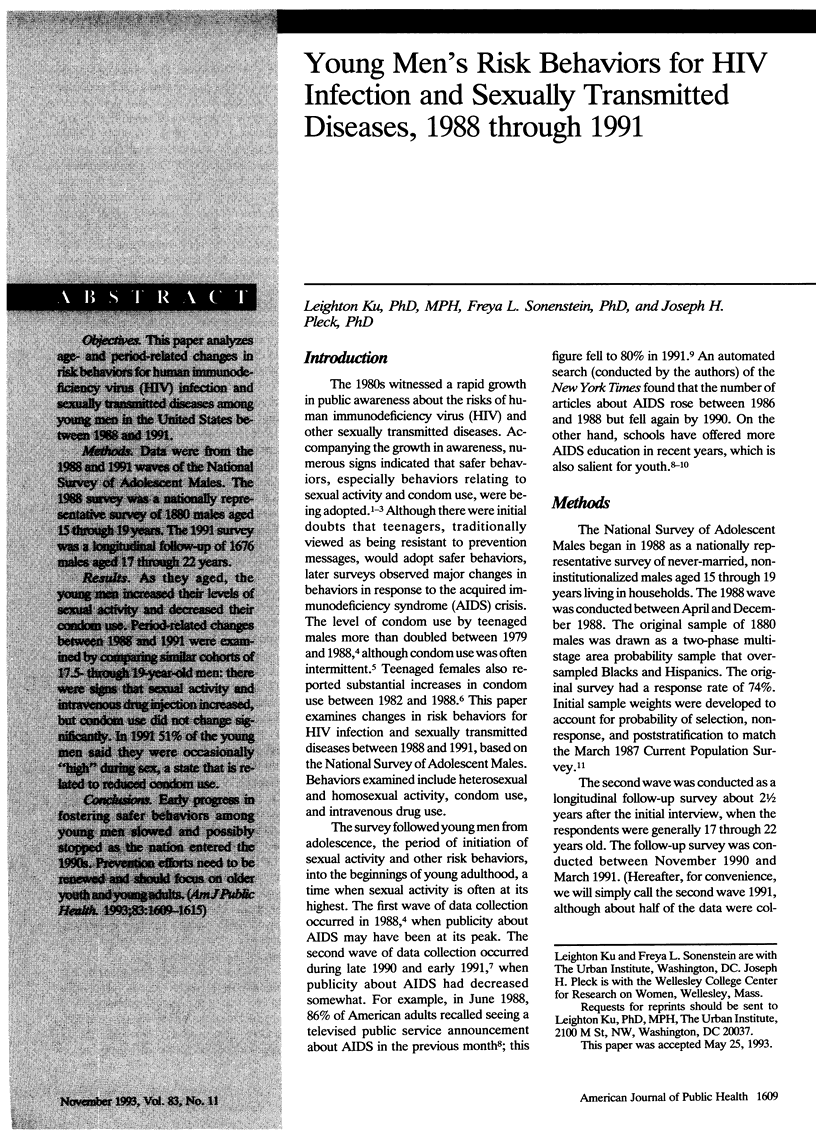Abstract
OBJECTIVES. This paper analyzes age- and period-related changes in risk behaviors for human immunodeficiency virus (HIV) infection and sexually transmitted diseases among young men in the United States between 1988 and 1991. METHODS. Data were from the 1988 and 1991 waves of the National Survey of Adolescent Males. The 1988 survey was a nationally representative survey of 1880 males aged 15 through 19 years. The 1991 survey was a longitudinal follow-up of 1676 males aged 17 through 22 years. RESULTS. As they aged, the young men increased their levels of sexual activity and decreased their condom use. Period-related changes between 1988 and 1991 were examined by comparing similar cohorts of 17.5- through 19-year-old men: there were signs that sexual activity and intravenous drug injection increased, but condom use did not change significantly. In 1991 51% of the young men said they were occasionally "high" during sex, a state that is related to reduced condom use. CONCLUSIONS. Early progress in fostering safer behaviors among young men slowed and possibly stopped as the nation entered the 1990s. Prevention efforts need to be renewed and should focus on older youth and young adults.
Full text
PDF






Selected References
These references are in PubMed. This may not be the complete list of references from this article.
- Becker M. H., Joseph J. G. AIDS and behavioral change to reduce risk: a review. Am J Public Health. 1988 Apr;78(4):394–410. doi: 10.2105/ajph.78.4.394. [DOI] [PMC free article] [PubMed] [Google Scholar]
- Billy J. O., Tanfer K., Grady W. R., Klepinger D. H. The sexual behavior of men in the United States. Fam Plann Perspect. 1993 Mar-Apr;25(2):52–60. [PubMed] [Google Scholar]
- Forrest J. D., Singh S. The sexual and reproductive behavior of American women, 1982-1988. Fam Plann Perspect. 1990 Sep-Oct;22(5):206–214. [PubMed] [Google Scholar]
- Hingson R. W., Strunin L., Berlin B. M., Heeren T. Beliefs about AIDS, use of alcohol and drugs, and unprotected sex among Massachusetts adolescents. Am J Public Health. 1990 Mar;80(3):295–299. doi: 10.2105/ajph.80.3.295. [DOI] [PMC free article] [PubMed] [Google Scholar]
- Hingson R., Strunin L., Berlin B. Acquired immunodeficiency syndrome transmission: changes in knowledge and behaviors among teenagers, Massachusetts statewide surveys, 1986 to 1988. Pediatrics. 1990 Jan;85(1):24–29. [PubMed] [Google Scholar]
- Holtzman D., Anderson J. E., Kann L., Arday S. L., Truman B. I., Kolbe L. J. HIV instruction, HIV knowledge, and drug injection among high school students in the United States. Am J Public Health. 1991 Dec;81(12):1596–1601. doi: 10.2105/ajph.81.12.1596. [DOI] [PMC free article] [PubMed] [Google Scholar]
- Ku L. C., Sonenstein F. L., Pleck J. H. The association of AIDS education and sex education with sexual behavior and condom use among teenage men. Fam Plann Perspect. 1992 May-Jun;24(3):100–106. [PubMed] [Google Scholar]
- Ku L., Sonenstein F. L., Pleck J. H. Patterns of HIV risk and preventive behaviors among teenage men. Public Health Rep. 1992 Mar-Apr;107(2):131–138. [PMC free article] [PubMed] [Google Scholar]
- Sonenstein F. L., Pleck J. H., Ku L. C. Levels of sexual activity among adolescent males in the United States. Fam Plann Perspect. 1991 Jul-Aug;23(4):162–167. [PubMed] [Google Scholar]
- Sonenstein F. L., Pleck J. H., Ku L. C. Sexual activity, condom use and AIDS awareness among adolescent males. Fam Plann Perspect. 1989 Jul-Aug;21(4):152–158. [PubMed] [Google Scholar]
- Trussell J., Strickler J., Vaughan B. Contraceptive efficacy of the diaphragm, the sponge and the cervical cap. Fam Plann Perspect. 1993 May-Jun;25(3):100-5, 135. [PubMed] [Google Scholar]


